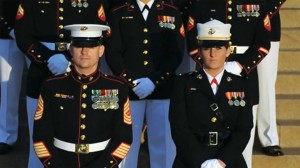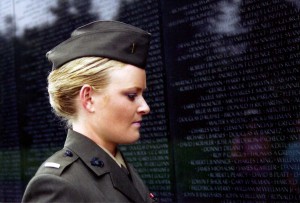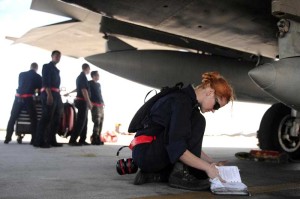
Documentaries can celebrate the true stories of people’s lives, follow mankind’s momentous events, even take us to exotic locations that we may never visit in person, but perhaps the most valuable use of the documentary form is its ability to expose systemic wrongs in an effort to make things right. Oscar contender The Invisible War takes on just such a challenge in investigating the shocking and all too pervasive occurrences of violent rape, and its bureaucratic cover-up, in the armed forces.
Astounded by an article he read noting the Department of Defense estimate that over 19,000 women and men were being sexually assaulted each year – hundreds of thousands over the last decade – director Kirby Dick realized that despite having made 10 feature documentaries, he had never come across a story that had been so covered up. “Ninety-nine percent of the public did not realize this epidemic was going on,” said Dick. “The stories were so powerful. These were young, idealistic, patriotic men and women who wanted a career in the military. The kind of people we want in our military. To have these experiences, I think these stories needed to be told.”
The act of rape was not the only dilemma facing these victims. “It was horrible enough that these women – mostly we’re dealing with women – were raped, but then when they decided to come forward and report it, the military turned on them in the most horrendous ways,” said Dick. “We personally spoke to three women who were all single, each raped by a married man, and the women were either charged or threatened to be charged with adultery.”

As is the case whenever anyone steps up to take on powerful institutions, one of the primary challenges is the “fear of speaking out.” Dick explained. ” I think our subjects were extremely courageous and had multiple reasons to be afraid. One, they were afraid that perhaps their perpetrators would come after them. Two, the last time they did speak out, the military turned on them aggressively so they were very cautious. We were able to convince them to be part of this very important project because they wanted to do everything they could to prevent another man or woman who is serving now from being raped in the military. This is personally what they all said.”
Producer Amy Ziering conducted most of the interviews with the women because Dick felt a female interviewer would create a much safer environment for the rape victims to share their stories. He and Ziering would craft the questions together in advance. “She would ask most of the personal questions then I would come in with more of the technical and journalistic questions,” shared Dick. “The whole project was completely a collaboration between Amy and I.”
Adding to the challenge of sensitive subject matter were the innate challenges of documentary filmmaking. Pre-production on the film began in February 2010 with the first shoots in April and May. Editing began in 2011 as shooting continued as late as December 2012 after the filmmakers were accepted into Sundance. The film was finished on HD cam two days before Sundance. Often Dick likes to begin editing even earlier because editing shows what is working and what is not working. It also allows the filmmakers to show material to others not involved in the project. Viewers react not just to the material, but also to engaging characters, helping the filmmakers adjust the direction of the story and their focus on the various characters

“I love to go back and forth between editing and shooting,” Dick said. “I love to shoot as late as possible because the story is always developing. I also like to start shooting as early as possible, even if it is just me shooting. Even before I have funding because the story is starting and you want to get that. The longer you are shooting, the longer your story arc is, and the longer your story arc is, the more you can craft the narrative.” Dick feels that even rough footage shot by the director in the early stages of a project can add a powerful element of interest and drama to the documentary because the audience can sense that “the director is out there really struggling to get the story right from the beginning.”
“I work very collaboratively with everyone that I work with,” said Dick. “I try to have that spirit of collaboration up and down the departments.” The film was shot all over the country. In addition to cinematographers, Thaddeus Wadleigh and Kirsten Johnson, Dick used a number of local camera operators, often in areas that did not have much of a film industry. The sensitive nature of the subject matter and the need for interviewees to feel comfortable sharing their stories necessitated a particularly subtle approach in the filming.
Wadleigh, who had worked on Dick’s film Outrage as well as Chris Paine‘s Who Killed the Electric Car, shot most of the interviews. Dick loves Wadleigh’s creative contributions to the film. “His lighting has a real naturalistic tone that doesn’t look particularly lit. There was an intimacy that he was able to set up. These were some of the most personal stories I’ve ever elicited from subjects so I wanted that real intimate feel from the lighting.”
“One of the things that is really important in a documentary is that the DP be very personable and sensitive because oftentimes it’s the DP who has the most interaction with the subject before the filmmaker sits down for the interview,” Dick explained. “That also sets the tone for the interview. Thad has incredible people skills. I find that is so important for a documentary shooter.”
Johnson, who was responsible for most of the vérité footage, also has that same quality, according to Dick. “I think it’s more typical for a vérité shooter to have that because they’re right in the thick of all these emotional things,” he said. “It’s really critical.”
In keeping with the need for a low profile while filming his subjects, Dick used radio mics to record the production sound since he felt that a boom mic in a vérité filming situation might be too distracting for a non-professional subject during an emotional interview. “I prefer radio mics. What happens is that oftentimes people forget that a film is being made. It’s less imposing. I would prefer to trade off a little in sound quality to make subjects feel more comfortable, particularly when the subject matter is so sensitive.”
Dick shoots as much film as possible in all different sorts of situations, resulting in hundreds of hours of film and a limited amount of time to construct the film. Even though he has an idea of where the film is going, ultimately he believes, “The film is really written in the editing room.”
“I work very closely with my editors,” he explained. “Editing a documentary is a very intimate, intense, personal experience. It’s like a family that you are a part of. I really try and create that. We’re all making this together. It’s not just me giving orders. I’m experienced. I know what I want. I know where I want to go. But in my mind, that best way to get to the best possible film is everybody’s collaborating, putting in their creative energy.”
Dick worked with editor and associate producer Doug Blush on his previous film Outrage. In addition to the editor’s technical abilities and collaborative nature, Dick said, “Doug is great to work with because he has a very good perspective on structure, which is so critical in editing a documentary. He is also politically very savvy and this is a political issue.”
Dick also acknowledged the film’s second editor, Derek Boonstra, who started the project before Blush came on board, and brought a lot to the project. The two editors were friends and consulted during each other’s editing. Dick also believes an assistant editor, like the film’s Edward Patrick Alva, plays an important role. “I really value getting assistant editors that are not only technically proficient, but have incredibly good judgment. Oftentimes they see more of the material than even the editor. Sometimes there are situations when we look at a cut and we have to go back and see what other material there is,” Dick explained. “If I can trust the assistant editor’s judgment, that’s really valuable.”
Although the director gets much of the glory, Dick mused about the idea of crediting ten people on the “Film By” card. “The reality is that this project, which is creating real change, is the result of dozens of people’s passion, hard work and skill,” he said.
And this “passion” project, despite focusing on the problems of rape within the armed forces, is not anti-military. Dick was smart enough to know that attacking the services would only cause them to close ranks. Instead he has instigated a dialog. “I wanted the film to help start a dialog, and that’s happening,” Dick said. The film has already contributed to changing policy in a number of ways. In fact, the military is using the film in its sexual assault training program. To date, up to 10 percent of military personnel have seen the film. “The military can change the system,” Dick argued. “The military, if they really step up and do it, can go a long way in solving this problem. It’s not all bleak. There’s hope.”





